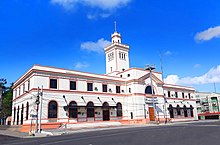| Tomás Mapúa | |
|---|---|
| Born | Tomás Mapúa y Bautista (1888-12-21)December 21, 1888 Binondo, Manila, Captaincy General of the Philippines |
| Died | December 22, 1965(1965-12-22) (aged 77) Manila, Philippines |
| Nationality | Filipino |
| Alma mater | Cornell University |
| Occupation | Architect |
| Spouse |
Rita Moya (m. 1916) |
| Children | Carmen Oscar Sr. Gloria |
| Parent(s) | Juan Mapúa Justina Bautista |
| Buildings | Mapúa Mansion, Librada Avelino Hall (Centro Escolar University) |
| Design | Manila Central Post Office, St. La Salle Hall |
Don Tomás Bautista Mapúa (December 21, 1888 – December 22, 1965) was a Filipino architect, educator and businessman from the Philippines. He was the founder and first president of the Mapúa Institute of Technology (MIT). Gonzalo T. Vales as co-founder and founding dean of school and co-founder and founding president of Central Colleges of the Philippines, after he established the school on February 25, 1925. He was the first registered architect in the Philippines and first worked at the Philippine Bureau of Public Works. He later established his own construction company, the MYT Construction Works, Inc.
Biography
Mapúa was born to Juan Mapúa and Justina Bautista de Mapúa on December 21, 1888, in Binondo, Manila. His education started at the Ateneo de Manila University and at the Liceo de Manila. In 1903, he was sent to the United States to complete his high school education and college education as one of the pensionado students of the United States. The 1903 Pensionado Law awarded university scholarships to the US for exemplary Filipino students. In exchange, they agreed to work on local government construction projects. He completed his secondary education at the Boone’s Preparatory School in Berkeley, California, and obtained a degree in architecture at Cornell University in Ithaca, New York.
Upon his return to the Philippines, he joined the Bureau of Public Works where he initially worked as a draftsman in the agency from 1912 to 1917. He was later appointed as the supervising architect for the Bureau from 1917 to 1928. He spearheaded many government projects including the Philippine General Hospital Nurses Home, Psychopathic Building (National Mental Hospital) and the School for the Deaf and Blind. He also designed the Manila Central Post Office Building in Ermita, Manila. Tomás became known for his great contributions in the field of architecture.


Around 1916, Mapúa joined the competition for the design of the new school building initiated by the La Sallian Brothers. He won the competition against nine other entries and was awarded with a prize of P5,000.00. (The building, St La Salle Hall, was the only structure from the Philippines to be included in the coffee table book, "1001 Buildings You Must See Before You Die: The World's Architectural Masterpieces," authored by Mark Irving and published by Quintessence Books in 2007.)
He was also one of the first councilors of the City of Manila. He co-founded and became one of the presidents of the Philippine Institute of Architects. After retiring from public life, he eventually went back to the private sector. Aside from MIT, he led his own construction firm called MYT Construction Works, Inc. His designs for private homes had also been adjudged as among Manila’s beautiful houses before World War II.
Personal life
Mapúa was married to Rita Moya on November 3, 1916. They have three children, Carmen, Oscar, and Gloria.
Death
He died on December 22, 1965, in Manila, just a day after his 77th birthday.
Legacy
His son Oscar continued his legacy in education by assuming the presidency of the Mapúa Institute of Technology after his death in 1965. Oscar served as the Institute’s president until his demise on March 17, 1998. His son and Tomás’ grandson, architect Oscar Mapúa Jr., succeeded him and was the institute’s executive vice president until December 1999, when the school was acquired by the Yuchengcos.

Misericordia Street in Santa Cruz, Manila was renamed to Tomas Mapua Street in his honor.
Awards
He was awarded a gold medal of honor and a certificate of recognition by the Philippine Institute of Architects. He also received a Cultural Award in Architecture by the city of Manila in 1964.
Works
| This section needs expansion. You can help by adding to it. (December 2021) |

- 1916: Aduana de Iloilo (Iloilo Customs House)
- 1924: St. La Salle Hall
- 1928: Manila Central Post Office (with Juan M. Arellano)
See also
- Mapua Mansion, the home of Tomas Mapua designed by himself.
References
- ^ "Tomas B. Mapua". History of Architecture. Retrieved on 2014-12-21.
- Nellist, G. Men of the Philippines: a biographical record of men of substantial achievement in the Philippine islands, Manila 1931
- "History – PIA". Retrieved 2023-01-22.
- ^ administration (2011). "History". Mapua Institute of Technology. Retrieved on 2014-12-21.
- ^ Villalon, Augusto (2009-04-12). "DLSU building included in int’l best-of list" Archived 2012-07-26 at the Wayback Machine. Philippine Daily Inquirer. Retrieved on 2014-12-21.
- Rubio, Paulo (2014-11-06). "De La Salle University St. La Salle Hall". Arquitectura Manila. Retrieved on 2014-12-21.
- Irving, Mark (2007). "1001 Buildings You Must See Before You Die: The World's Architectural Masterpieces", pg. 390. Quintessence Books, London. ISBN 978-0789315649.
- "P123M for restoration of two city heritage buildings". Retrieved November 22, 2018.